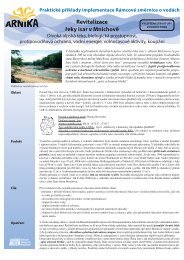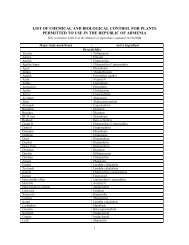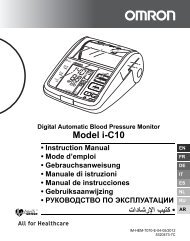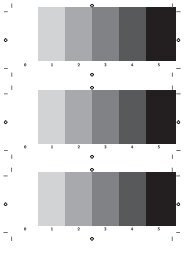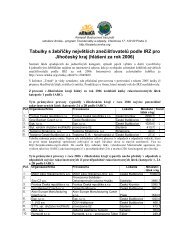Microlife BP A200 AFIB - Arnika
Microlife BP A200 AFIB - Arnika
Microlife BP A200 AFIB - Arnika
Create successful ePaper yourself
Turn your PDF publications into a flip-book with our unique Google optimized e-Paper software.
If you are pregnant, you should monitor your blood pressure<br />
very closely as it can change drastically during this time!<br />
If you suffer from an irregular heartbeat, measurements taken<br />
with this instrument should only be evaluated after consultation<br />
with your doctor.<br />
The pulse display is not suitable for checking the<br />
frequency of heart pacemakers!<br />
How do I evaluate my blood pressure?<br />
Table for classifying blood pressure values in adults in accordance<br />
with the World Health Organisation (WHO) in 2003. Data in mmHg.<br />
Range Systolic Diastolic Recommendation<br />
blood pressure too low 100 60 Consult your<br />
doctor<br />
1. blood pressure<br />
optimum<br />
100 - 120 60 - 80 Self-check<br />
2. blood pressure normal 120 - 130 80 - 85 Self-check<br />
3. blood pressure slightly<br />
high<br />
4. blood pressure too<br />
high<br />
5. blood pressure far too<br />
high<br />
6. blood pressure<br />
dangerously high<br />
130 - 140 85 - 90 Consult your<br />
doctor<br />
140 - 160 90 - 100 Seek medical<br />
advice<br />
160 - 180 100 - 110 Seek medical<br />
advice<br />
180 110 Urgently seek<br />
medical advice!<br />
The higher value is the one that determines the evaluation.<br />
Example: a readout value between 150/85 or 120/98 mmHg indicates<br />
«blood pressure too high».<br />
2. Important facts about atrial fibrillation (<strong>AFIB</strong>)<br />
What is Atrial Fibrillation (<strong>AFIB</strong>)?<br />
Normally, your heart contracts and relaxes to a regular beat.<br />
Certain cells in your heart produce electrical signals that cause the<br />
heart to contract and pump blood. Atrial fibrillation occurs when<br />
rapid, disorganized electrical signals are present in the heart’s two<br />
upper chambers, called the atria; causing them to contract quickly<br />
fast and irregularly (this is called fibrillation). Atrial fibrillation is the<br />
most common form of heart arrhythmia or irregular heart beat. You<br />
can live with atrial fibrillation, but it can lead to other rhythm problems,<br />
chronic fatigue, heart failure and - worst of all - a stroke.<br />
You’ll need a doctor to help you control the problem.<br />
How does <strong>AFIB</strong> impact my family or me?<br />
One in every six strokes is <strong>AFIB</strong>-related. Whilst individuals above the<br />
age of 65 are more likely to have <strong>AFIB</strong>, individuals as young as 40<br />
can exhibit <strong>AFIB</strong>. Early diagnosis can help reduce the risk of a stroke.<br />
<strong>Microlife</strong> <strong>AFIB</strong> detection provides a convenient way to screen<br />
for <strong>AFIB</strong> (only in MAM mode)<br />
Knowing your blood pressure and knowing whether or not you or<br />
your family members have <strong>AFIB</strong> can help reduce the risk of stroke.<br />
<strong>Microlife</strong> <strong>AFIB</strong> detection provides a convenient way to screen for<br />
<strong>AFIB</strong> whilst taking your blood pressure.<br />
Risk factors you can control<br />
High blood pressure and <strong>AFIB</strong> are both considered «controllable»<br />
risk factors for strokes. Knowing your blood pressure and knowing<br />
whether or not you have <strong>AFIB</strong> is the first step in proactive stroke<br />
prevention.<br />
3. Using the Instrument for the First Time<br />
Activating the fitted batteries<br />
Pull out the protective strip from the battery compartment AT.<br />
Setting the date and time<br />
1. After the new batteries are fitted, the year number flashes in the<br />
display. You can set the year by pressing the M-button 2. To<br />
confirm and then set the month, press the time button 5.<br />
2. Press the M-button to set the month. Press the time button to<br />
confirm and then set the day.<br />
3. Follow the instructions above to set the day, hour and minutes.<br />
4. Once you have set the minutes and pressed the time button, the<br />
date and time are set and the time is displayed.<br />
5. If you want to change the date and time, press and hold the time<br />
button down for approx. 3 seconds until the year number starts<br />
to flash. Now you can enter the new values as described above.<br />
Selecting the correct cuff<br />
<strong>Microlife</strong> offers different cuff sizes. Select the cuff size to match the<br />
circumference of your upper arms (measured by close fitting in the<br />
centre of the upper arm).<br />
Cuff size for circumference of upper arm<br />
S 17 - 22 cm (6.75 - 8.75 inches)<br />
M 22 - 32 cm (8.75 - 12.5 inches)<br />
L 32 - 42 cm (12.5 - 16.5 inches)<br />
M - L 22 - 42 cm (8.75 - 16.5 inches)<br />
<strong>BP</strong> <strong>A200</strong> Afib 3 EN



